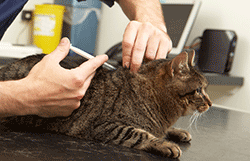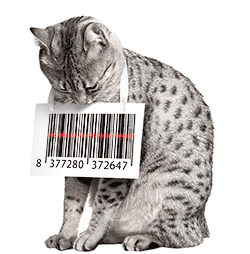Microchip your kitten or cat
It is standard practice to have your cat microchipped, ensuring you can be quickly contacted should your cat become lost or injured.

What is the 'microchip'
It is easy to think of a microchip as a big black box with bits of metal coming out, but in reality the microchip used for animal identification is tiny - about the same size as a grain of rice. Its tiny size means it can be implanted with a simple injection in seconds, with no harm to the cat, and at almost any age. Microchips require no permanent power source and only transmit data when scanned. The chip is implanted at the back of the neck between the shoulder blades and in most cases it will stay in this location for the cats life (sometimes they can slip a bit)
Cost of microchipping
You can get your cat microchipped at your vets, at a welfare centre, and even some pet stores and should cost very little. Some chipping providers also offer additional services (for a small fee) including free updating of details, additional details and phone numbers of friends and family, online details management, or automatic alerting of local vets and charities if your cat goes missing.
Details held on a microchip
The microchip itself only holds a single code, but when read by a scanner this code will supply details held on a database. Only registered scanning organisations can access this data and it will typically include your name, address and telephone number as well as your vets details and your cats name, age, and breed. There are several databases held by different companies but they generally share their data so that scanners can work regardless of who made the microchip.

There are alternatives, but microchipping your cat is best!
Changing your cats information
Should you need to update the details, such as a change of address or phone number, or a change of ownership you will need to contact the organisation which holds your cats details. You should have been given this information when the cat was microchipped but if you do not have it you will have to visit a vet or charity with a scanner who can access the data, verify you are the cats owner or contact the cats owner before providing you with the code on the chip and the details of the organisation who holds the database record.
Why you should always microchip your cat
Hopefully, the microchip inside your cat will never need to be used but should your cat become lost or injured it could be literally a case of life or death. Cat's get lost easily, and are often caught hiding in vehicles, ending up many miles from home. Without any obvious identification your cat would probably end up in a rescue centre and either rehomed or put down. In the case of injury, your cat may be found and taken to a vet, but if the cost of treatment is significant then the stranger who found your cat or the vet are unlikely to pay themselves, and the most likely outcome is euthanasia.
Microchipping is more reliable than collars and tags, which can easily be lost or damaged, and will ensure you can be quickly contacted should your cat become injured, ill, or lost.


